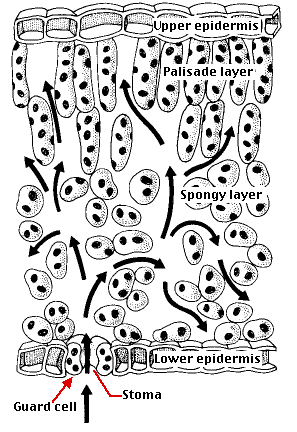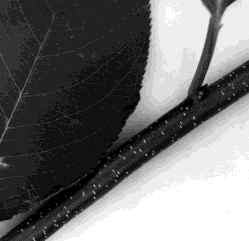
In order to carry on photosynthesis, green plants need a supply of carbon dioxide and a means of disposing of oxygen. In order to carry on cellular respiration, plant cells need oxygen and a means of disposing of carbon dioxide (just as animal cells do).
Unlike animals, plants have no specialized organs for gas exchange (with the few inevitable exceptions!). The are several reasons they can get along without them:
The exchange of oxygen and carbon dioxide in the leaf (as well as the loss of water vapor in transpiration) occurs through pores called stomata (singular = stoma).
Normally stomata open when the light strikes the leaf in the morning and close during the night.The immediate cause is a change in the turgor of the guard cells. The inner wall of each guard cell is thick and elastic. When turgor develops within the two guard cells flanking each stoma, the thin outer walls bulge out and force the inner walls into a crescent shape. This opens the stoma. When the guard cells lose turgor, the elastic inner walls regain their original shape and the stoma closes.
| Time | Osmotic Pressure, lb/in2 |
|---|---|
| 7 A.M. | 212 |
| 11 A.M. | 456 |
| 5 P.M. | 272 |
| 12 midnight | 191 |
The table shows the osmotic pressure measured at different times of day in typical guard cells. The osmotic pressure within the other cells of the lower epidermis remained constant at 150 lb/in2. When the osmotic pressure of the guard cells became greater than that of the surrounding cells, the stomata opened. In the evening, when the osmotic pressure of the guard cells dropped to nearly that of the surrounding cells, the stomata closed.
Although open stomata are essential for photosynthesis, they also expose the plant to the risk of losing water through transpiration. Some 90% of the water taken up by a plant is lost in transpiration.
ABA is the hormone that triggers closing of the stomata when soil water is insufficient to keep up with transpiration (which often occurs around mid-day).
The mechanism:
Woody stems and mature roots are sheathed in layers of dead cork cells impregnated with suberin - a waxy, waterproof (and airproof) substance. So cork is as impervious to oxygen and carbon dioxide as it is to water.
However, the cork of both mature roots and woody stems is perforated by nonsuberized pores called lenticels. These enable oxygen to reach the intercellular spaces of the interior tissues and carbon dioxide to be released to the atmosphere.The photo shows the lenticels in the bark of a young stem.
In many annual plants, the stems are green and almost as important for photosynthesis as the leaves. These stems use stomata rather than lenticels for gas exchange.
| Welcome&Next Search |